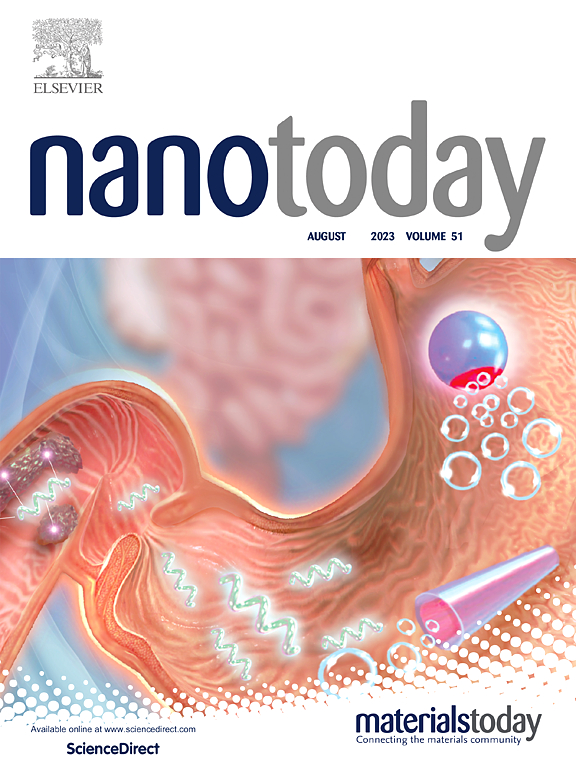In situ microneedle-based system with “Tripartite Delivery” characteristics for local antisense oligonucleotide therapy in acute bacterial infections
IF 10.9
1区 材料科学
Q1 CHEMISTRY, MULTIDISCIPLINARY
引用次数: 0
Abstract
The management of the acute bacterial infections in the traumatic skin remains a significant challenge in clinical. The application of antibiotics on wounds is typically avoided due to antimicrobial resistance risks. Antisense therapeutics, like antisense oligonucleotides (ASOs), present a selective, low-resistance alternative, but effective bacterial uptake is still a major obstacle. In this work, we developed a novel microneedle-based delivery system (MNDS) distinguished by its distinctive multifunctional hydrogels and a “Tripartite Delivery” mechanism. The MNDS was designed with a bionic mushroom-shaped multilayered structure. Upon application, the MNDS enabled an initial rapid release and sustained release of the encapsulated nanocomplexes (ASO@GP-SiNPs). The needle body layer hydrogels can respond to hyaluronidase and continuously release hyaluronic acid and ε-polylysine for several days. These ASO@GP-SiNPs were effectively uptaken by E. coli (46.4 %) and S. aureus (37.1 %), subsequently releasing ASOs that target the acpP and ftsZ genes to effectively eliminate bacteria. The system exhibits significant antibacterial activity and effectively inhibits biofilm formation, while also inducing the polarization of macrophages toward an M2-like phenotype. Additionally, the system demonstrates excellent biocompatibility. In conclusion, this paper presents a novel strategy for addressing the challenges of acute bacterial infections in traumatic skin by utilizing the advanced functionalities of MNDS.
具有“三方递送”特性的原位微针系统用于急性细菌感染的局部反义寡核苷酸治疗
创伤性皮肤急性细菌感染的处理仍然是临床面临的重大挑战。由于抗菌素耐药性风险,通常避免在伤口上使用抗生素。反义疗法,如反义寡核苷酸(ASOs),是一种选择性的、低耐药性的替代疗法,但有效的细菌摄取仍然是一个主要障碍。在这项工作中,我们开发了一种新型的基于微针的递送系统(MNDS),其特点是其独特的多功能水凝胶和“三方递送”机制。MNDS采用仿生蘑菇状多层结构设计。应用后,MNDS使封装的纳米复合物的初始快速释放和持续释放(ASO@GP-SiNPs)。针体层水凝胶对透明质酸酶有反应,连续数日释放透明质酸和ε-聚赖氨酸。这些ASO@GP-SiNPs被大肠杆菌(46.4% %)和金黄色葡萄球菌(37.1% %)有效吸收,随后释放出靶向acpP和ftsZ基因的ASOs,从而有效地消灭细菌。该系统具有显著的抗菌活性,并能有效抑制生物膜的形成,同时还能诱导巨噬细胞向m2样表型极化。此外,该系统具有良好的生物相容性。总之,本文提出了一种利用MNDS的先进功能来解决创伤性皮肤急性细菌感染挑战的新策略。
本文章由计算机程序翻译,如有差异,请以英文原文为准。
求助全文
约1分钟内获得全文
求助全文
来源期刊

Nano Today
工程技术-材料科学:综合
CiteScore
21.50
自引率
3.40%
发文量
305
审稿时长
40 days
期刊介绍:
Nano Today is a journal dedicated to publishing influential and innovative work in the field of nanoscience and technology. It covers a wide range of subject areas including biomaterials, materials chemistry, materials science, chemistry, bioengineering, biochemistry, genetics and molecular biology, engineering, and nanotechnology. The journal considers articles that inform readers about the latest research, breakthroughs, and topical issues in these fields. It provides comprehensive coverage through a mixture of peer-reviewed articles, research news, and information on key developments. Nano Today is abstracted and indexed in Science Citation Index, Ei Compendex, Embase, Scopus, and INSPEC.
 求助内容:
求助内容: 应助结果提醒方式:
应助结果提醒方式:


